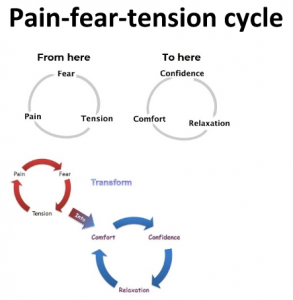Take a Light Breath – Through Your Nose
While we know and explore a variety of pregnancy classes using breathing to manage the intensity of labor, the underlying physiology is rarely explained. What they have in common is the use of breathing as a centering tool for focus and staying present, magic by itself. But there is more to breathing.
We all breathe; we wouldn’t be alive otherwise. It’s one of the most basic human functions. When a baby is born, we all wait for the first cry, the first exhale, the first autonomous act. There is a short transition time when the umbilical cord is still pulsing and the baby is still receiving maternal oxygen supply and nutrients as a backup system to guarantee a gentle arrival on land, being airborne. Then the cord is cut and the baby is on her/his own to breathe. A reflexive instinctual act governed by the low brain, calibrated and fine tuned to life’s demands and circumstances if things go well.
“We assume that the body reflexively knows how much air it needs at all times, but unfortunately this is not the case. Over the centuries we have altered our environment so dramatically that many of us have forgotten our innate way of breathing. The process of breathing has been warped by chronic stress, sedentary lifestyles, unhealthy diets, overheated homes, and lack of fitness. All of these contributes to poor breathing habits.“ (Patrick McKeown: The Oxygen Advantage)
So what do you do? How can we find our way to functional breathing? Breathe through your nose! All day, all night, through heavy exercise—always. Nose breathing naturally warms, humidifies and filters the air we breathe. It increases nitric-oxide six to eighteenfold in our sinuses keeping viruses and bacteria in check and preparing our lungs to open up deeply for optimal oxygen exchange, allowing up to 18% more oxygenation (James Nestor: Breath)
Breathe less!
Well that sounds counter-intuitve. Patrick McKeown explains: “The crucial point to remember is that hemoglobin releases oxygen when in the presence of carbon dioxide. When we over-breathe, too much carbon dioxide is washed from the lungs, blood, tissues, and cells. This condition is called hypocapnia, causing the hemoglobin to hold on to oxygen, resulting in reduced oxygen release and therefore reduced oxygen delivery to tissues and organs. With less oxygen delivered to the muscles, they cannot work as effectively. As counterintuitive as it may seem, the urge to take bigger, deeper breaths when we hit the wall during exercise does not provide the muscles with more oxygen but effectively reduces oxygenation even further.”
Pregnancy brings on special circumstances for almost everything, including breathing. The increased blood volume with a constant steady expansion up to 60% by week 30 of gestation often brings on congested airways. The baby’s growth pushes the uterus into the abdominal cavity with increased pressure on the diaphragm and lungs. Additionally increased progesterone ensures that the uterus has enough dilated blood vessels to nourish the baby, while also being a respiratory stimulant, quickening breathing. Both oxygen consumption and CO2 production increase 20-30% by the third trimester necessitating increased breathing rate, so a degree of hyperventilation is normal in pregnancy.
However, a woman may already have a degree of hyperventilation/hypocapnia prepregnancy as a consequence of, for example, habitual mouth breathing or snoring, chronic anxiety, or asthma. In this case a further increase in breathing volume and rate, a normal change of pregnancy, can quickly have adverse side effects for mom and baby alike.
 So the secret is breathe through your nose: slow, gentle, soft and tender. It will soothe your mind, taking you immediately out of a fight-flight response. Now imagine you are humming, giving you focus while at the same time increasing nitric-oxide six to fifteenfold which will increase your capacity of ‘deep breathing’. But deep in the sense slow and gentle breaths for optimal oxygen exchange in the lower lobes of your lungs by preserving enough carbon dioxide for optimized oxygenation including the smooth muscles of the uterus.
So the secret is breathe through your nose: slow, gentle, soft and tender. It will soothe your mind, taking you immediately out of a fight-flight response. Now imagine you are humming, giving you focus while at the same time increasing nitric-oxide six to fifteenfold which will increase your capacity of ‘deep breathing’. But deep in the sense slow and gentle breaths for optimal oxygen exchange in the lower lobes of your lungs by preserving enough carbon dioxide for optimized oxygenation including the smooth muscles of the uterus.
Simple gentle slow breathing: in through your nose, out through your nose — magic!
Diaphragmatic Breathing
All breathing involves the diaphragm. It defines, separates, and connects the thoracic and the abdominal cavities. The heart is resting on the dome of the diaphragm, gently bounced and rocked with each breath while underneath the viscera – the stomach, liver, spleen, pancreas, kidneys and the upper portions of the intestines – is cradled under the diaphragmatic tent. Each unhindered, unrestricted breath, approximately 20.000 times a day, gives all organs a gentle massage. Air comes in, the diaphragm gentle extends down and out and bounces back with each exhale, a rhythmic gentle movement. More a horizontal expansion of the rib cage than a vertical motion. If you allow just that, you will automatically look for length in your torso, alignment of your neck and head. Your posture can restrict or invite your breath.
Here is a way to experiment: close your mouth, role your tongue gently over the bony pallet, way back to the soft tissue, lengthen your tongue upwards, breathe, – feel your rib cage expanding, your breathing slowing….. an invitation to diaphragmatic breathing.
Nadi Shodhana – Alternate Nostril Breathing
Melissa Eisler https://chopra.com/articles/nadi-shodhana-how-to-practice-alternate-nostril-breathing
Nadi Shodhana, is a classic pranayama technique improving lung function, lowering heart rate, blood pressure, and sympathetic stress. You can use it to quiet your mind before beginning a meditation practice or go to a job interview. It is particularly helpful to ease racing thoughts if you are experiencing anxiety, stress, or having trouble falling asleep.
- Take a comfortable and tall seat, making sure your spine is straight and your heart is open. Relax your left palm comfortably into your lap.
- With your right hand, bring your pointer finger and middle finger to rest between your eyebrows, lightly using them as an anchor.
- Close your right nostril with your thumb, and inhale through the left nostril very slowly.
- At the top of the breath, pause briefly holding both nostrils closed, then lift just the thumb to exhale through the right nostril.
- At the natural conclusion of the exhale, hold both nostrils closed for a moment, then inhale through the right nostril.
Continue alternating breaths through the nostrils for five to ten cycles.
Nose Songs
Additionally, you can experiment with humming through your exhales. It will naturally add a layer of focus and calm while increasing nitric-oxide, a powerhouse molecule that widens capillaries, increases oxygenation, and relaxes the smooth muscles. Humming increases the release of nitric oxide in the nasal passages up to 15-fold.
- Breath normally through the nose and hum, any song or sound.
- Practice for at least five minutes a day, more if possible.
VIDEO—Robin Rothenberg https://www.youtube.com/watch?v=gSCAZL8bD2Q
FUNDAMENTALS:
Breath – Move – Eat – Sleep – Repeat
Pranayama Mantra
I receive the inhale
I release the exhale
I pause in between breaths
I lovingly accept the inhale
I gently let go of the exhale
I pause to enjoy the moment between breaths
I quietly receive the in breath
I quietly release the out breath
I pause in the stillness between breaths
The inhale comes
The exhale goes
The pause happens
I receive the inhale
I release the exhale
I pause to rest
Space moves within
Space moves without
I rest in the infinite space
I receive the element of space
I release the element of space
I rest in the infinite space
within and without
Summer Cushman
“Your breath should be light, even, and flowing, like a thin stream of water running through the sand. Your breath should be very quiet, so quiet that a person sitting next to you cannot hear it. Your breathing should flow gracefully, like a river, like a water-snake crossing the water, not like a chain for rugged mountains or the gallop of a horse. To master our breath is to be in control of our bodies and minds.”
Thich Nhat Hanh (2008): The Miracle of Mindfulness
“To bring air down into the depths of the lungs, it is not actually necessary to take a big breath, as even the quietest of breaths will activate the diaphragm. When you are practicing abdominal nasal breathing, you should not be able to see or hear your breath during rest.”
Patrick McKeown: The Oxygen Advantage
Literature
Patrick McKeown (2015): The Oxygen Advantage
Robin L. Rothenberg (2020): Restoring Prana
James Nestor (2020): Breath. The New Science of a Lost Art.
Tess Graham: Snoring in Pregnancy: Risks, Reasons and Remedies wwww.breathability.com

 If we allow this first skin to skin contact we can observe nine newborn stages with specific actions happening in a specific order; they are innate and instinctive for the baby. This first skin-to-skin contact should happen immediately, without a delay for any routine procedures. If the mother has had analgesia/anesthesia during labor, it may take more time with skin to skin for the baby to complete the stages and begin suckling – the reflexes may be dampened, but they are still there!
If we allow this first skin to skin contact we can observe nine newborn stages with specific actions happening in a specific order; they are innate and instinctive for the baby. This first skin-to-skin contact should happen immediately, without a delay for any routine procedures. If the mother has had analgesia/anesthesia during labor, it may take more time with skin to skin for the baby to complete the stages and begin suckling – the reflexes may be dampened, but they are still there!
 Most women ruminate about labor pain in childbirth; rarely it is not mentioned as one of the main challenges.
Most women ruminate about labor pain in childbirth; rarely it is not mentioned as one of the main challenges. These earliest life-forms- bacteria, viruses, archaea, fungi- live on and in our bodies and call us home. We depend on these trillions of microbes, which outnumber our genetic cells, for proper functioning. The unique interplay of genes and microbes determines most of our health, diseases, mood, fertility and longevity. While we as human beings have closely related genetic codes, our individual gut microbiomes are vastly different. It is this interplay between genes and microbes which builds diversity in gene expression. Much like a fingerprint, each person’s microbiome is unique.
These earliest life-forms- bacteria, viruses, archaea, fungi- live on and in our bodies and call us home. We depend on these trillions of microbes, which outnumber our genetic cells, for proper functioning. The unique interplay of genes and microbes determines most of our health, diseases, mood, fertility and longevity. While we as human beings have closely related genetic codes, our individual gut microbiomes are vastly different. It is this interplay between genes and microbes which builds diversity in gene expression. Much like a fingerprint, each person’s microbiome is unique. Did you know the average adult is comprised of 50-65% water and we can survive only a few days without it? Water is essential for cells to function properly, enables the biochemical breakdown of food, contributes to the transportation of nutrients, and helps to regulate body temperature. A sign of being well-hydrated is having a clear urine color, as opposed to dark yellow.
Did you know the average adult is comprised of 50-65% water and we can survive only a few days without it? Water is essential for cells to function properly, enables the biochemical breakdown of food, contributes to the transportation of nutrients, and helps to regulate body temperature. A sign of being well-hydrated is having a clear urine color, as opposed to dark yellow.